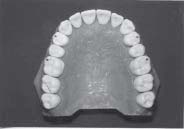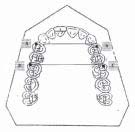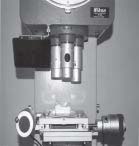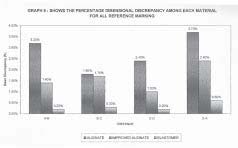INTORDUCTION
Partial edentulism is one of the commonest prosthodontic problems we come across. These conditions are frequently treated by Removable and Fixed partial dentures. Since the introduction of Alginate in year 1947 it is one of the commonly
used materials for recording the partial edentulous condition. But the studies have shown that the Alginates are not dimensionally stable and accurate enough to be used as impression material for the fixed partial prosthesis. For the last couple of years to overcome the deficiencies of Alginate materials various companies came out with the improved alginates which have better quality, and dimensional accuracy as similar as compared to that of Elastomers.
AIMS AND OBJECTIVES
The main aim of study was to compare the dimensional accuracy of alginate with that of improved alginate, and the dimensional accuracy of improved alginate with that of Elastomer.
MATERIAL AND METHODS
In this study the six different materials were taken. These materials were divided into three different groups.
FIRST GROUP Alginates
A: Zelgan( Densply India)
B: Alginoplast (Heraeus and Kulzar)
SECOND GROUP IMPROVED ALGINATES
A: Litochrom (Lasod Italy)
B: Cavex (Cavex Holland)
THIRD GROUP ELASTOMERS
A: Putty consistency
elastomer (3 m India,Reprosil India)
B: Light body elastomer (3m India, Reprosil India)
These all specimen impression was poured with Type IV die stone gypsum products.
PREPARATION OF MASTER MODEL:
The frasaco (Germany) maxillary dentulous model was selected and reference making of one mm in diameter made on the buccal cusps of first premolar and mesio- buccal cusps of first molar using round diamond burs as shown in fig 1. These marking were made on 14, 24, 26, 16 teeth and were named as A, B, C and D respectively. As shown in fig 2.
 | Fig 1. Reference marking on frasaco dentulous model
 |
 | Fig 2. Reference making on cast
 |
The distance between the above markings were measured with a profile projector microscope and kept as a stranded value. The frasaco model was mounted on the phantom head. using each group of impression materials, 14 impressions was made. Impressions were poured with type IV die stone. Measurements were made between 4
reference points. From A to B, B to C, C to D, and D to A. Using Nikon profile projector microscope (Japan) as shown in Fig 3. The reading was obtained from casts poured from different impression materials and subjected to statical
analysis.
DISCUSSION
From the beginning of 18th and 19th centuries many researches are going on to improve the accuracy of the impression material. In 1937 sears first time used the agar hydrocolloid impression material. In 1947 the irreversible hydrocolloid
came into the existence. The advantages of the alginates are discussed by the Skinner and Pomes –1)Low cost 2)Low heat is necessary for the
 | Fig 3 Nikon profile projector microscope
 |
preparation 3)No danger of burning of oral mucosa of the patient 4)Sufficient fluidity prior to the time of elation5)Reduced risk of trapping the air. Caul H.J 1- Outlined the techniques to avoid the inaccuracies during the use of alginates impression material. 1) Alginate mix should have smooth creamy consistency. 2) Precooling the instruments and use of cool water. 3) Impression should be removed with sudden snap about 2-3 min after the time of set. 4) Impression shouldpour instantly and removed after the pouring. Andrew etal 2 -conducted study on the accuracy of new alginates and traditional alginates ccording to them new alginates are 2-3 times costly than the alginate. But their study does not
indicate that increased price correspond to that ofthe similar increased in success of impression. Chi-lin-c 3- They proved from their study that toovercome the disadvantages of alginates, in the recent past year, several new materials, basedupon the alginates have been introduced into the market which can be used for the impression for
 | Fig 4 Shows percentage dimensional discrepancy among each material for all reference markings
 |
fixed partial prosthesis. B.A. linke etal4 - has found in his study stone cast made from Silicon impression materials produced less interbutment distortion than the irreversible hydrocolloid and also state that the statically significant difference exist among the different impression materials. Present study proves that the significant difference exists in interabutment distance of cast made from elastomers, alginates and improved alginates and shows similar results as that of study of B.A .Linke.
RESULTS:
The specimen were analyzed statically by wil coxon’s signed rank test, One way ANOVAS test and student Newman kaul’s test. Themeasurements are obtained with the mean value in millimeters and micrometers. The results show
that the improved alginates are better than the alginates as shown in graph in figure 4.
CONCULSION:
The result of this vitro study showed that improved alginate better than alginate. These are more dimensionally accurate and shows lessinterabutment distortion than the alginate. These materials have comparable surface details as compared to that of the elastomers. So these canbe used as impression materials for fixed partial dentures in place of elastomers so as to reduce the cost factor. But the elastomers are the still more accurate. So the further studies are required to co relate this study clinically.
REFERNCES
1. Caul H.J.: “Alginate Impression Materials.”J Am Dent Assoc. 1957; 54:567-569.
2. Andrew Errikson., Gudrum Ockert-Eriksson., Paul lockowandt and lark-Ake Linden.: “Irreversible hydrocolloids
for crown and bridge impression: effect of different treatment on compatibility of irreversible hydrocolloid impression
material with type IV gypsum ’’. Dent mater1996; 12:74-82.
3. Chi-Lin-c., Donegan S.J., Dhuru V.B. “Accuracy of impression materials for complete arch fixed partial dentures.”
J Prosthet Dent1988; 59:288-291.
4. Linke B.A., icholls J.I., Faucher R.R., “Distortion analysis of stone cast made from impression materials.”J Prosthet Dent 1985; 54:794-802.
5. Anusavice J.K.: “Science of Dental Material .’’ 10 th Edition, 1990, P. 130.
6. Agarwal N.K., Chandra Suresh., Singh S.L.: “A study of indigenously produced hydrocolloids.” Journal of Indian
Dental Association 1970; 42:173-176.
7. Baily L.R.: “Acrylic resin trays for rubber base impression materials” J Prosthet Dent1955; 5:658.
8. Dounis G.S., Ziebert G.J., Dounis K.S.: “A comparison of impression materials for complete arch fixed partial dentures.”J Prosthet Dent1991; 65:165-169.
9. Eames W.B., Sieweke J.C., Wallace S.W. and Rogers L.B.: “Elastomeric impression materials: effect of bulk on accuracy.” J Prosthet Dent1979; 41:304-307. |